Rebecca Oppenheimer ’94 studies some of the oddest objects in the universe.
Columbia College | Columbia University in the City of New York
Rebecca Oppenheimer ’94 studies some of the oddest objects in the universe.
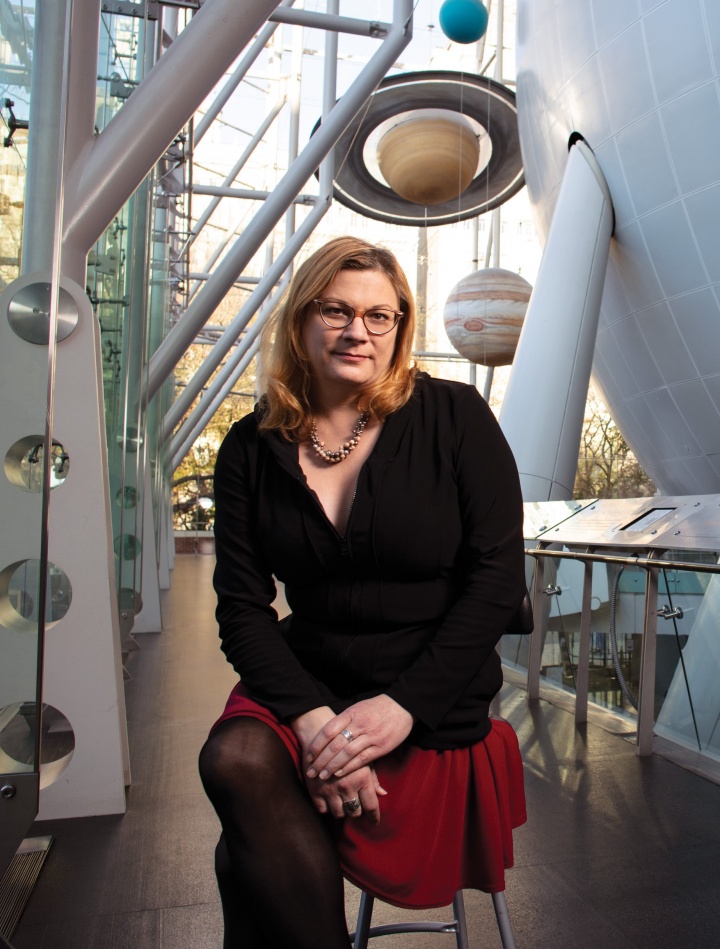
Jörg Meyer
She also studies some of the oddest objects in the universe — celestial bodies governed by what is known, incidentally, as degeneracy pressure. These include brown dwarfs — bigger than planets but smaller than stars — which she and her collaborators were the first to discover, just months after she graduated from Columbia. “I’ve worked on degenerates for most of my life,” she said at the Bukowski lecture. “It’s nice to be able to work on something you love.”
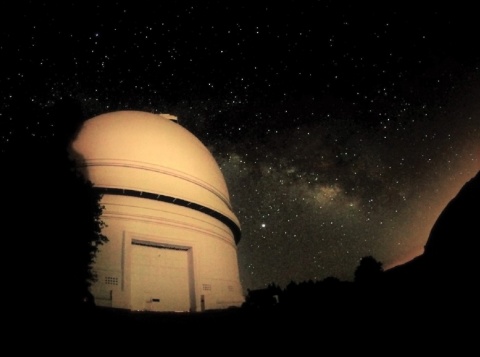
The 200-inch Hale Telescope dome, at Palomar Observatory.
Rebecca Oppenheimer ’94
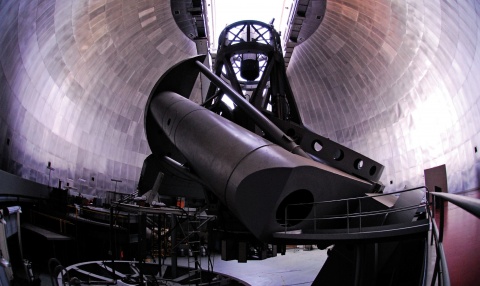
The Hale Telescope dome sits open to the sky before a night of observing.
Rebecca Oppenheimer ’94
While many instruments are the size of a bus, PARVI is only a couple of feet across, connected to the telescope by a long fiber optic cable. “It’s a bunch of new technologies tested out in this tiny little machine to see if they’ll all work,” says Oppenheimer’s current graduate student, Rose Gibson GSAS’22. “If we can show that this really compact structure can measure these insanely tiny signals, that would mean a lot for new instrument design.”
It could also mean the ability to detect one of astronomy’s holy grails: an Earthlike planet around a Sunlike star. In other words, a potential home to life outside our solar system.
OPPENHEIMER GREW UP on the Upper West Side, less than a mile from Columbia. She was interested in how things worked and read books about science, including one by astronomer Patrick Moore that told the folklore behind various stars. By 12, she’d saved enough to buy her own telescope and would camp out near her grandfather’s house on eastern Long Island to observe the night sky. In high school she worked at the Goddard Institute of Space Studies and modeled river flow with computers.
She attended the College partially out of a reluctance to leave the city she loved, though told her parents to pretend she was much farther away, and they happily obliged. (Classmates may remember her as Ben; she came out as transgender in 2014, though she’d always known who she was.) Oppenheimer loved her time at Columbia. “The professors that I got tied into were just wonderful,” she says. “The one who helped me the most is David Helfand, my undergrad advisor.” Helfand, a giant in the field, is also a past president of the American Astronomical Society and was longtime chairman of Columbia’s Department of Astronomy. Together they examined satellite data, identifying clusters of galaxies. They also spent a week at an observatory in Arizona identifying sources of X-ray radiation. The two still meet up regularly for beers, Helfand says, to talk shop or gossip about “astropolitics.”
Oppenheimer spent summers working at Goddard or visiting large telescopes in New Mexico and Puerto Rico. Outside her physics major, she took classes in architecture and theater, having designed sets in high school. She admits astronomy and theater are not the most practical of pursuits. “What I do is not very useful,” she reckons, “but I think some of the most useless things that people do are some of the most important, actually.”
WHEN YOU THINK OF a large celestial body, you likely imagine a star, like the Sun, or a planet, like Earth (or a galaxy, like the Milky Way, comprising billions of stars and planets). But there’s also a middle ground: brown dwarfs. These gas giants are 13–75 times the mass of Jupiter, but not big enough for gravitational pressure to initiate nuclear fusion and render them a star. What keeps them from collapsing further is degeneracy pressure, a result of quantum mechanics that prevents electrons with the same energy state from occupying the same region of space. Brown dwarfs had been theorized but, like exoplanets — planets outside our solar system — for years they made their presence known only on chalkboards and in science fiction. Some doubted their existence.
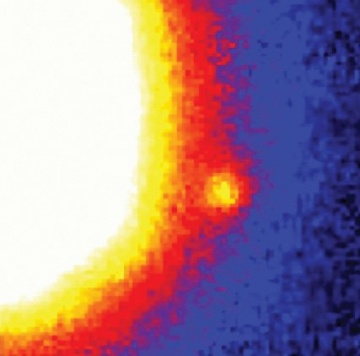
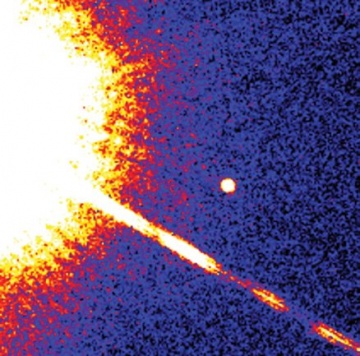
Oppenheimer and her team first saw a brown dwarf in the glare of a brighter star (image above), then confirmed it via a second photo taken a year later.
NASA
“We were like, ‘Holy shit, this is really amazing,’” Oppenheimer says. The object was very red, similar to what one would expect for a brown dwarf. (Brown dwarfs were named before their color was known, brown being sort of a non-color.) She excitedly wrote calculations in an absent collaborator’s tidy notebook, amended with “Sorry for this mess, Tadashi. — Ben.” Oppenheimer wanted to publish, but Kulkarni enforced temperance. It could have been merely another star behind the first star, so they waited a year to look again and see if it moved across the sky along with Gliese 229.
It did. And this time they used Palomar’s 200-inch telescope, which had an infrared camera. “It was just so dramatically unlike a star, there was no question that this was some kind of new beast,” Oppenheimer says. It was glowing — heat from compressed gas — with frequencies suggesting its atmosphere contained methane, which stars are too hot to contain. The team published papers in Science and Nature a couple months later and made the front page of The New York Times.
Oppenheimer has continued to study brown dwarfs, which have the interesting property of remaining about the same size no matter their mass, and white dwarfs, dense stars that are actually smaller the more massive they are. “I like to try to find the wacky stuff,” she says. “That’s my passion. And so that’s partly why I work on instrumentation. It’s only with new capabilities that you’re going to find something that nobody has ever seen before.”
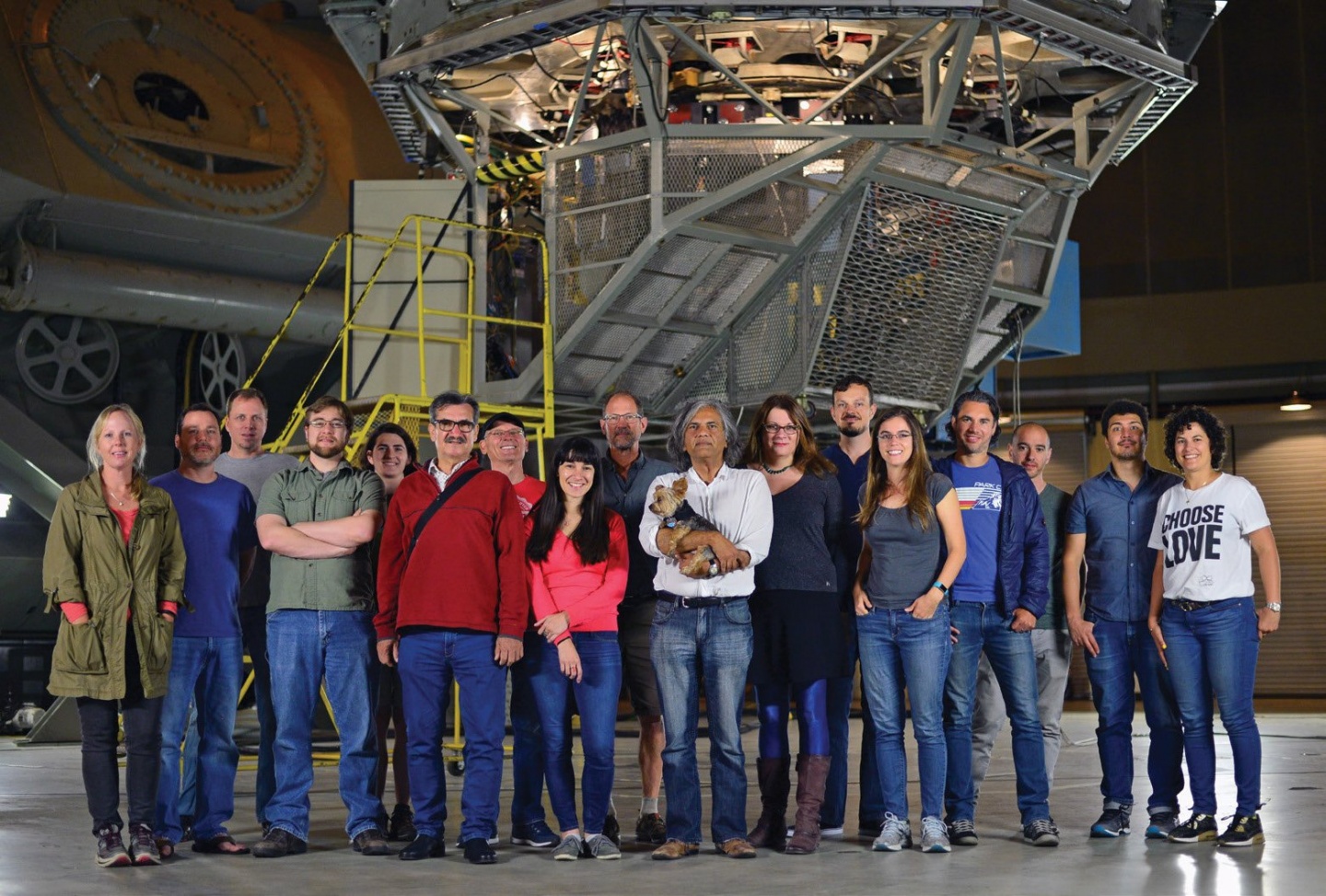
Oppenheimer with her teammates, the Palomar Mountain staff and project spokesdog Paco.
Rebecca Oppenheimer ’94
OVER ZOOM, Oppenheimer led me on a tour of her optics lab, next to the Hayden Planetarium at the AMNH. She pointed out work tables scattered with lasers and lenses and mirrors and tools, and racks of computers and hard drives. Nothing is being built at the moment, but normally she’d have to don a white bodysuit to keep everything pristine. She’s written that the precision required in her work is equivalent to photographing the entire Empire State Building and pointing, in the photo, to a bump on the pavement and saying it’s exactly 4.43 millionths of a meter tall. “She’s really innovative when it comes to working on instrument design,” her graduate student, Gibson, says, “and seeing what kinds of weird things you can put together to create some totally bizarre instrument nobody else would have thought of.” (Oppenheimer also builds things for fun. In her office is a model of an F-14 fighter jet — the kind from Top Gun — and she’s working on a customized model of the HMS Beagle, the survey vessel known for carrying Darwin to the Galápagos and, she says, “the first thoroughly scientific ship ever built.”)
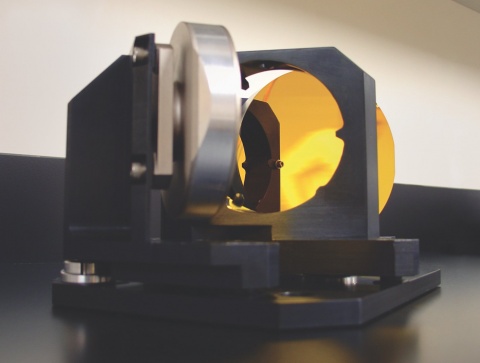
Gold-coated optics that were part of an imaging spectrograph.
Rebecca Oppenheimer ’94
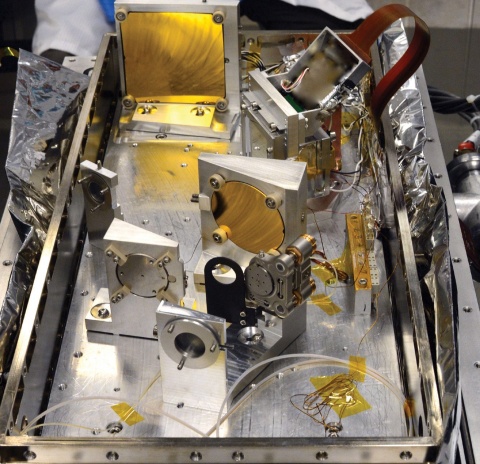
A look inside the PARVI spectrograph’s vacuum chamber.
Rebecca Oppenheimer ’94
Unfortunately, Oppenheimer’s hands are currently left with little to do. After only six nights of use, PARVI had to lie dormant. Palomar is shut down due to social distancing restrictions in the face of the pandemic. “It’s heartbreaking,” Oppenheimer says. “This is a big part of my student’s thesis. And we’ve got about 10, 15 people involved in this project. We just have to sit and wait.”
JUST AS OPPENHEIMER prefers deep involvement in small projects, she also prefers to advise only one graduate student at a time. “She’s been very successful mentoring the students she’s had from our department” — such as Gibson — Helfand says. “What makes people successful as a mentor is sufficient sensitivity, which not all scientists have, to be able to recognize another human being there who’s not the same as you. But also just the genuine love and enthusiasm for what you’re doing.”
Working with Oppenheimer is “a lot of fun,” Gibson says. They spend a lot of time together outside of lab, driving to mountain observatories or collecting data, “so it really matters that our personalities get along,” Gibson says. “And she’s said multiple times there’s no point in doing science if you’re not having fun with it.” Oppenheimer also loves the unique teaching opportunities offered by the museum. She curates exhibitions, like one on exoplanets called Searching for New Worlds, and creates space shows for the planetarium, like Journey to the Stars. “Part of what I love about this place is it’s totally anti-elitist,” she says. “We get five million people a year. And they’re paying money to come and see all the science and stuff that we do. I think that’s really fucking cool.”
Gibson can vouch for Oppenheimer’s inclusivity. “She’s the kind of person who knows the names of all the security guards and custodians at AMNH and will stop and chat with them,” Gibson says. “And I love that, because science can feel so isolating sometimes. She makes it an environment where it feels like everybody is a part of it.”
“Her academic energy and productivity are a model for graduate students, postdocs and visiting scholars,” says Neil deGrasse Tyson GSAS’92, the popular astrophysicist and director of the Hayden Planetarium. “I remember her as an undergraduate at Columbia, while I was there as a graduate student. Years later I was delighted to see her career launch, and have her return to NYC when we hired her.”
“Her academic energy and productivity are a model for graduate students, postdocs and visiting scholars,” says the popular astrophysicist Neil deGrasse Tyson.
Oppenheimer’s coming out as transgender may also have made astrophysics more welcoming to some people. “I think that makes a lot of people feel more comfortable being themselves in the field,” she says. She calls the decision “terrifying,” but she couldn’t keep up the act anymore. Most, but not all, colleagues have been supportive.
EVERY YEAR, Oppenheimer spends a month on a writing retreat, typically in the tropics because she loves hurricanes. This past October she had to settle for New Jersey, where she worked on a book that touches on the topic of labels. Without revealing much, she teases that it’s a science book arguing that “planets don’t exist,” spiked with some “ridiculous anecdotes.” Oppenheimer has written previously that classifications, whether of natural objects (planet) or people (Jew), can constrain our thinking about them. Soon after coming out as transgender, she defined the best practices of a scientist in The New York Times: “question who, where and what you are.” The book may tackle some of that self-questioning on a species level, engaging directly with philosophy: Where did the universe come from? What would it mean if life is widespread in the cosmos?
Helfand has long appreciated that expansive thinking in Oppenheimer. “Her research is very focused on highly sophisticated engineering solutions to problems of how you look at very faint things around very bright things,” he says. “That kind of person, in our field at least, is often pretty blinkered. And she’s just the opposite.”
Eventually the pandemic will pass, and Oppenheimer will return to looking at the stars, and whatever else remains unknown and unlabeled. “The regions around stars are still so poorly understood,” she says. “And it’s so diverse, with different types of planets, brown dwarfs, comets, dust, whatever. These little points of light up in the sky are actually some of the most complex things that people ever look at. There’s so much going on, not only inside each star, but also right around them. And I think that’s really a fun thing to do. And to devote a large fraction of my life to. I certainly won’t do this forever. But for now, it really is my passion.”
Matthew Hutson is a freelance science writer in New York City who writes for The New Yorker, Scientific American, Nature and other publications. He’s the author of The 7 Laws of Magical Thinking.

Published three times a year by Columbia College for alumni, students, faculty, parents and friends.
Columbia Alumni Center
622 W. 113th St., MC 4530, 6th Fl.
New York, NY 10025
212-851-7852
cct@columbia.edu

Columbia Alumni Center
622 W. 113th St., MC 4530, 4th Fl.
New York, NY 10025
212-851-7488
ccalumni@columbia.edu